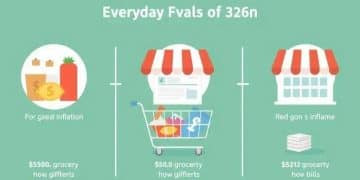Budgeting tips for families 2025: make your money go further

Budgeting tips for families in 2025 include analyzing spending patterns, setting realistic financial goals, using budgeting tools, and cutting unnecessary expenses to achieve greater financial stability.
Budgeting tips for families 2025 are essential for managing finances effectively. With rising costs, every dollar counts. How can we stretch our budget while ensuring our family’s needs are met? Let’s explore some practical strategies.
Understanding the basics of family budgeting
Understanding the basics of family budgeting is crucial for effective financial management. Many families struggle to keep track of their spending and savings, which can lead to financial stress. Let’s break down the essential elements of family budgeting in a simple and engaging way.
What is Family Budgeting?
Family budgeting involves planning your income and expenses to meet your family’s financial goals while ensuring that you live within your means. It’s not just about cutting costs but also about prioritizing spending and ensuring that your financial needs are met.
Key Components of a Family Budget
Creating a successful budget involves several key components:
- Income: This is the total amount of money coming into your household, including salaries, bonuses, and any additional sources.
- Fixed Expenses: These are costs that don’t change month to month, like rent or mortgage payments.
- Variable Expenses: These expenses can vary, such as groceries, utilities, and entertainment.
- Savings and Investment: Always include a portion of your income to save for emergencies and future goals.
Maintaining a family budget requires consistent monitoring and adjustments. It’s important to track your spending habits and compare them to your budget plan regularly. This helps identify areas where you may need to cut back or where you may be able to reallocate your funds for better savings.
Communication within the family is key. Discuss your budget openly, involving all members in the process, this encourages responsibility and understanding of financial goals. By teaching children about budgeting early, they can learn valuable lessons that will benefit them in the future.
Setting realistic financial goals

Setting realistic financial goals is a vital step in managing your family’s budget effectively. It enables you to prioritize your spending and ensures that you stay on track with your financial plan. Understanding what you want to achieve financially can make a significant difference in your budgeting process.
Why Set Financial Goals?
Establishing clear goals gives you a target to aim for. Without goals, it’s easy to lose sight of your financial priorities. When you have specific objectives, you can tailor your budget to meet those needs effectively. This not only motivates you but also helps in tracking your progress over time.
Types of Financial Goals
When setting goals, consider dividing them into three key categories:
- Short-term goals: These are objectives you hope to achieve within the next year, such as saving for a family vacation or paying off a small debt.
- Medium-term goals: Goals that take one to five years to achieve, like saving for a new car or a home renovation.
- Long-term goals: These are typically five years or more and include savings for your children’s education or retirement planning.
Achieving these goals requires careful planning and commitment. It’s important to make them specific and measurable. For example, instead of saying, “I want to save money,” aim for “I will save $5,000 for a vacation by next summer.” This clarity helps you focus your efforts.
Reviewing your goals regularly is also essential. Life changes, and your financial goals may need to adjust accordingly. Set a schedule to revisit and revise your goals, ensuring they remain relevant to your family’s situation. By keeping your objectives fresh, you can adapt to any challenges that may arise.
Strategies to cut unnecessary expenses
Strategies to cut unnecessary expenses can significantly improve your family’s budgeting efforts. Finding areas where you can save money allows for better allocation towards your financial goals. It’s essential to evaluate your spending habits to identify potential savings.
Analyze Your Spending
The first step in cutting costs is to analyze your spending patterns. Look at your bank statements and categorize your expenses into needs and wants. This will provide a clear picture of where your money is going. Often, families discover that they are spending too much on non-essential items.
Implementing Cost-Cutting Techniques
Here are some practical techniques to reduce expenses:
- Plan Meals: Create a weekly meal plan to reduce impulse purchases at the grocery store. Stick to your list while shopping to avoid buying unnecessary items.
- Limit Dining Out: Eating out can quickly add up. Set a budget for dining out and try to cook at home more often.
- Negotiate Bills: Contact your service providers to negotiate better rates or look for cheaper alternatives. Don’t be afraid to shop around for better prices.
- Cancel Unused Subscriptions: Review all subscriptions and memberships. Cancel those that are no longer used or don’t provide value.
Reducing utility usage is another effective strategy. Turn off lights when leaving a room, unplug devices, and consider energy-efficient appliances. These small changes can lead to significant savings over time.
Also, consider using public transportation or carpooling instead of driving everywhere. It can save on gas and reduce wear and tear on your vehicle. Adopting a frugal mindset within the family can also lead to smarter spending choices.
Tools and apps to streamline budgeting

Tools and apps to streamline budgeting can make managing your family’s finances much easier. With the right tools at your disposal, you can track your expenses, set financial goals, and analyze your spending habits more effectively. The convenience of technology helps families stay organized and informed about their financial status.
Benefits of Using Budgeting Tools
Utilizing budgeting tools can save you time and stress. They often automate calculations and help visualize your financial data. This visualization can aid in making informed decisions. Using apps also allows for real-time updates, so your budget stays current.
Popular Budgeting Apps to Consider
Here are some effective budgeting apps to explore:
- Mint: This app connects to your bank accounts and automatically categorizes your transactions. It provides spending insights and allows you to set budgets and financial goals.
- YNAB (You Need A Budget): YNAB encourages you to allocate every dollar you earn and provides real-time feedback on your spending. It teaches you budgeting skills that can empower your family.
- EveryDollar: This straightforward app allows you to create a budget from scratch. You can customize your categories, making it user-friendly for families.
- PocketGuard: This app helps you track your spending and shows how much you have left to spend after bills, goals, and necessities.
Choosing the best app for your family depends on your specific needs and preferences. Many of these tools offer features like bill reminders, savings trackers, and even financial education resources. Take some time to explore and find the one that fits your lifestyle best.
In addition to apps, consider using spreadsheets for budgeting if you prefer a more hands-on approach. A simple spreadsheet can help you keep track of income and expenses while allowing for customization to suit your needs.
FAQ – Frequently Asked Questions about Family Budgeting
What is family budgeting?
Family budgeting is the process of planning and managing your family’s finances by tracking income and expenses to achieve financial goals.
Why should we set financial goals?
Setting financial goals helps prioritize your spending and keeps the family focused on achieving specific outcomes, improving financial stability.
How can we cut unnecessary expenses?
Identify non-essential items in your budget, like eating out frequently or unused subscriptions, and make adjustments to save money.
What tools are available to help with budgeting?
There are many budgeting apps like Mint, YNAB, and EveryDollar that can automate tracking and help you manage finances effectively.





